Modbus
EdgeX - Delhi Release
PowerScout 3037 Power Submeter
https://shop.dentinstruments.com/products/powerscout-3037-ps3037 https://www.dentinstruments.com/hs-fs/hub/472997/file-2378482732-pdf/Pdf_Files/PS3037_Manual.pdf

In this example, we simulate the PowerScout meter instead of using a real device. This provides a straight-forward way to test the device-modbus features.

Environment
You can use any operating system that can install docker and docker-compose. In this example, we use Photon OS to delpoy EdgeX using docker. The system requirements can be found at https://docs.edgexfoundry.org/Ch-GettingStartedUsers.html#what-you-need.
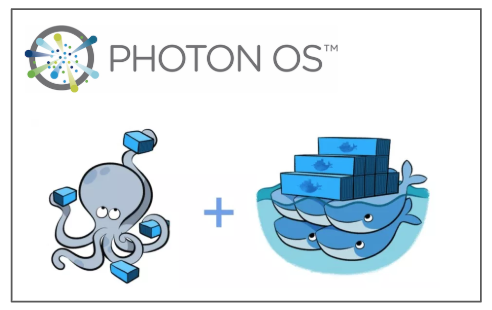

Modbus Device (Simulator)
http://modbuspal.sourceforge.net/
To simulate sensors, such as temperature and humidity, do the following:
- Add two mock devices:
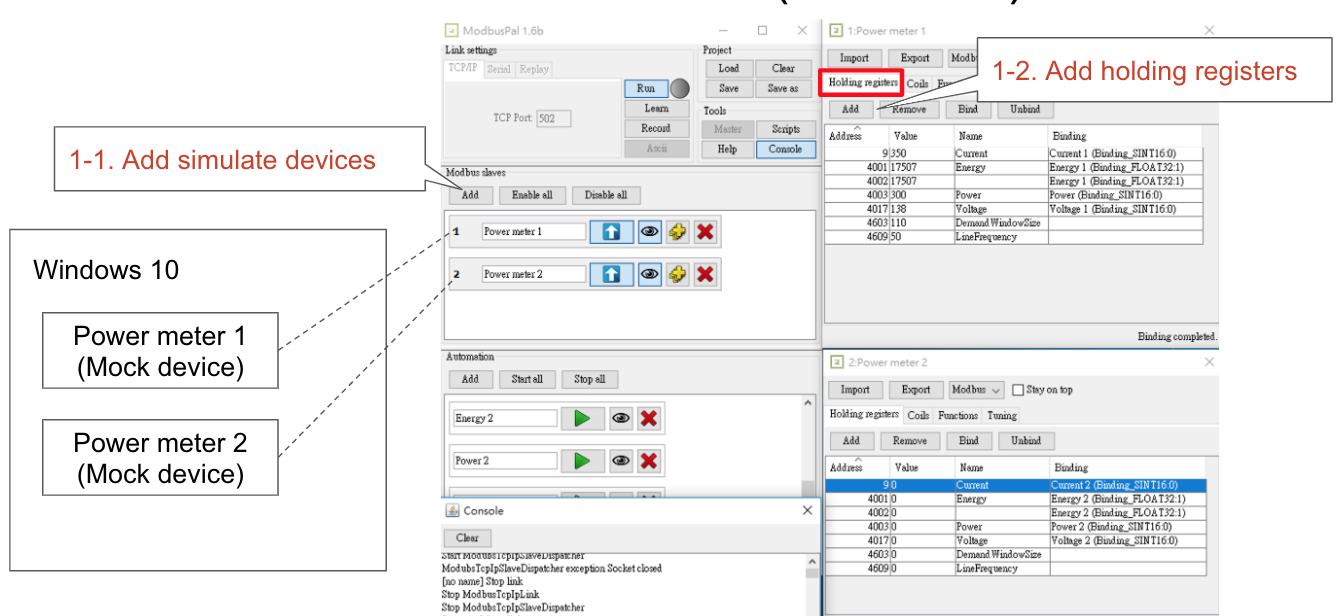
- Add registers according to the device manual:

- Add the ModbusPal support value auto-generator, which can bind to registers:
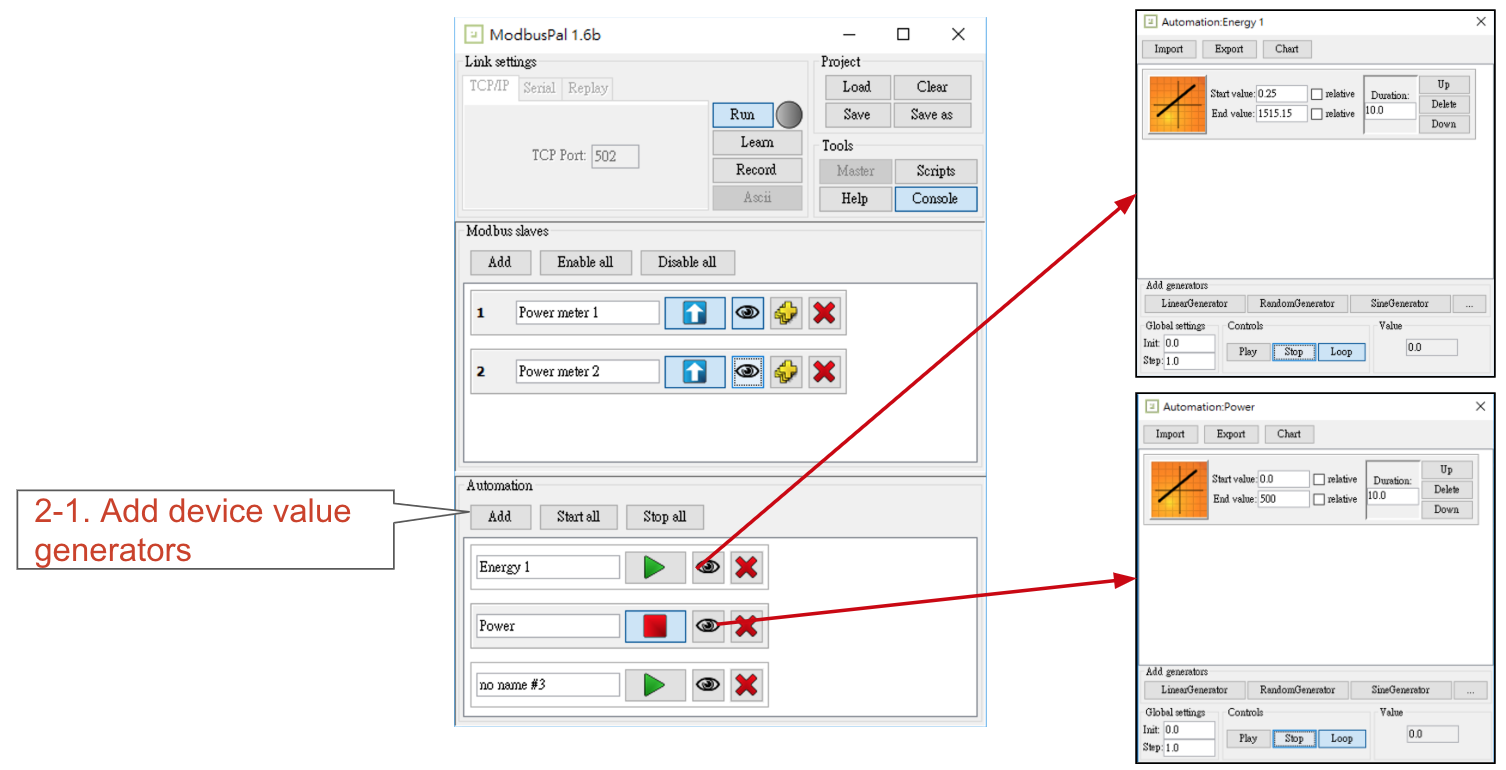

Set Up Before Starting Services
The following sections describe how to complete the set up before starting the services. If you prefer to start the services and then add the device, see Set Up After Starting Services
Set Up Device Profile
The DeviceProfile defines the device's values and operation method, which can be Read or Write.
In the Modbus protocol, we must define attributes:
-
primaryTable: HOLDING_REGISTERS, INPUT_REGISTERS, COILS, DISCRETES_INPUT -
startingAddressspecifies the address in Modbus device

The Property value type decides how many registers will be read. Like Holding registers, a register has 16 bits. If the device manual specifies that a value has two registers, define it as FLOAT32 or INT32 or UINT32 in the deviceProfile.
Once we execute a command, device-modbus knows its value type and register type, startingAddress, and register length. So it can read or write value using the modbus protocol.


Create the device profile, as shown below:
name: "Network Power Meter"
manufacturer: "Dent Instruments"
model: "PS3037"
description: "Power Scout Meter"
labels:
- "modbus"
- "powerscout"
deviceResources:
-
name: "Current"
description: "Average current of all phases"
attributes:
{ primaryTable: "HOLDING_REGISTERS", startingAddress: "9" }
properties:
value:
{ type: "UINT16", scale: "1"}
units:
{ type: "String", readWrite: "R", defaultValue: "min"}
-
name: "Energy"
description: "System Total True Energy"
attributes:
{ primaryTable: "HOLDING_REGISTERS", startingAddress: "4001" }
properties:
value:
{ type: "FLOAT32", scale: "1"}
units:
{ type: "String", readWrite: "R", defaultValue: "min"}
-
name: "Power"
description: "System Total True Power "
attributes:
{ primaryTable: "HOLDING_REGISTERS", startingAddress: "4003" }
properties:
value:
{ type: "UINT16", scale: "1"}
units:
{ type: "String", readWrite: "R", defaultValue: "min"}
-
name: "Voltage"
description: "Voltage Line to line (Volts) Average"
attributes:
{ primaryTable: "HOLDING_REGISTERS", startingAddress: "4017" }
properties:
value:
{ type: "UINT16", scale: "1"}
units:
{ type: "String", readWrite: "R", defaultValue: "min"}
-
name: "DemandWindowSize"
description: "Demand window size in minutes; default is 15 min"
attributes:
{ primaryTable: "HOLDING_REGISTERS", startingAddress: "4603" }
properties:
value:
{ type: "UINT16", readWrite: "R", scale: "1"}
units:
{ type: "String", readWrite: "R", defaultValue: "min"}
-
name: "LineFrequency"
description: "Line frequency setting for metering: 50=50 Hz, 60=60Hz"
attributes:
{ primaryTable: "HOLDING_REGISTERS", startingAddress: "4609" }
properties:
value:
{ type: "UINT16", readWrite: "R", scale: "1"}
units:
{ type: "String", readWrite: "R", defaultValue: "Hz"}
deviceCommands:
-
name: "Current"
get:
- { index: "1", operation: "get", deviceResource: "Current" }
-
name: "Values"
get:
- { index: "1", operation: "get", deviceResource: "Energy" }
- { index: "2", operation: "get", deviceResource: "Power" }
- { index: "3", operation: "get", deviceResource: "Voltage" }
-
name: "Configuration"
set:
- { index: "1", operation: "set", deviceResource: "DemandWindowSize" }
- { index: "2", operation: "set", deviceResource: "LineFrequency" }
get:
- { index: "1", operation: "get", deviceResource: "DemandWindowSize" }
- { index: "2", operation: "get", deviceResource: "LineFrequency" }
coreCommands:
-
name: "Current"
get:
path: "/api/v1/device/{deviceId}/Current"
responses:
-
code: "200"
description: "Get the Current"
expectedValues: ["Current"]
-
code: "500"
description: "internal server error"
expectedValues: []
-
name: "Values"
get:
path: "/api/v1/device/{deviceId}/Values"
responses:
-
code: "200"
description: "Get the Values"
expectedValues: ["Energy","Power","Voltage"]
-
code: "500"
description: "internal server error"
expectedValues: []
-
name: "Configuration"
get:
path: "/api/v1/device/{deviceId}/Configuration"
responses:
-
code: "200"
description: "Get the Configuration"
expectedValues: ["DemandWindowSize","LineFrequency"]
-
code: "500"
description: "internal server error"
expectedValues: []
put:
path: "/api/v1/device/{deviceId}/Configuration"
parameterNames: ["DemandWindowSize","LineFrequency"]
responses:
-
code: "204"
description: "Set the Configuration"
expectedValues: []
-
code: "500"
description: "internal server error"
expectedValues: []
Set Up Device Service Configuration
Use this configuration file to define devices and AutoEvent. The device-modbus generates a relative instance on startup.
device-modbus offers two types of protocol, Modbus TCP and Modbus RTU, which can be defined as shown below:
| protocol | Name | Protocol | Address | Port | UnitID | BaudRate | DataBits | StopBits | Parity |
|---|---|---|---|---|---|---|---|---|---|
| Modbus TCP | Gateway address | TCP | 10.211.55.6 | 502 | 1 | ||||
| Modbus RTU | Gateway address | RTU | /tmp/slave | 502 | 2 | 19200 | 8 | 1 | N |
In the RTU protocol, Parity can be: * N - None is 0 * O - Odd is 1 * E - Even is 2, default is E
Create the configuration.toml file, as shown below:
[Writable]
LogLevel = 'DEBUG'
[Service]
BootTimeout = 30000
CheckInterval = '10s'
Host = 'localhost'
ServerBindAddr = '' # blank value defaults to Service.Host value
Port = 49991
Protocol = 'http'
StartupMsg = 'device modbus started'
Timeout = 5000
ConnectRetries = 10
Labels = []
EnableAsyncReadings = true
AsyncBufferSize = 16
[Registry]
Host = 'localhost'
Port = 8500
Type = 'consul'
[Logging]
EnableRemote = false
File = ''
[Clients]
[Clients.Data]
Protocol = 'http'
Host = 'localhost'
Port = 48080
[Clients.Metadata]
Protocol = 'http'
Host = 'localhost'
Port = 48081
[Clients.Logging]
Protocol = 'http'
Host = 'localhost'
Port = 48061
[Device]
DataTransform = true
InitCmd = ''
InitCmdArgs = ''
MaxCmdOps = 128
MaxCmdValueLen = 256
RemoveCmd = ''
RemoveCmdArgs = ''
ProfilesDir = './res/example'
UpdateLastConnected = false
# Pre-define Devices
[[DeviceList]]
Name = 'Modbus TCP test device'
Profile = 'Test.Device.Modbus.Profile'
Description = 'This device is a product for monitoring and controlling digital inputs and outputs over a LAN.'
labels = [ 'Air conditioner','modbus TCP' ]
[DeviceList.Protocols]
[DeviceList.Protocols.modbus-tcp]
Address = '0.0.0.0'
Port = '1502'
UnitID = '1'
[[DeviceList.AutoEvents]]
Frequency = '20s'
OnChange = false
Resource = 'Configuration'
[[DeviceList.AutoEvents]]
Frequency = '20s'
OnChange = true
Resource = 'Values'
[[DeviceList]]
Name = 'Modbus RTU test device'
Profile = 'Test.Device.Modbus.Profile'
Description = 'This device is a product for monitoring and controlling digital inputs and outputs over a LAN.'
labels = [ 'Air conditioner','modbus RTU' ]
[DeviceList.Protocols]
[DeviceList.Protocols.modbus-rtu]
Address = '/tmp/slave'
BaudRate = '19200'
DataBits = '8'
StopBits = '1'
Parity = 'N'
UnitID = '1'
Add Device Service to docker-compose File
Because we deploy EdgeX using docker-compose, we must add the device-modbus to the docker-compose file ( https://github.com/edgexfoundry/developer-scripts/blob/master/releases/geneva/compose-files/docker-compose-geneva-redis.yml ). If you have prepared configuration files, you can mount them using volumes and change the entrypoint for device-modbus internal use.
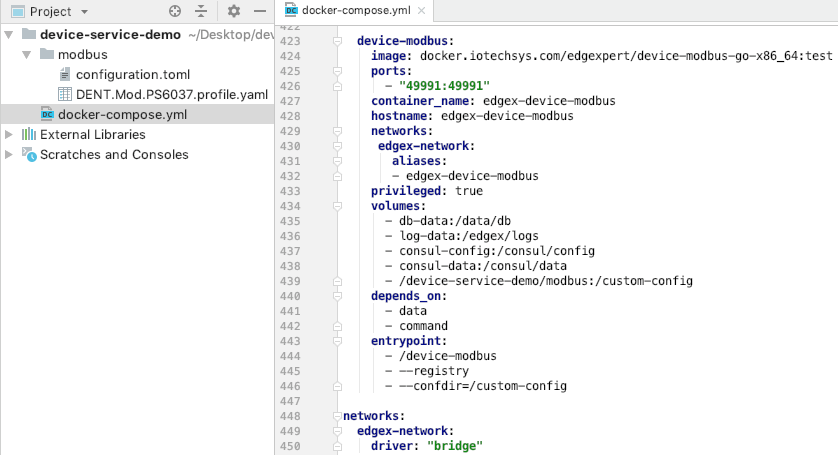
Start EdgeX Foundry on Docker
Finally, we can deploy EdgeX in the Photon OS.
-
Prepare configuration files by moving the files to the Photon OS
-
Deploy EdgeX using the following commands:
docker-compose pull docker-compose up -d
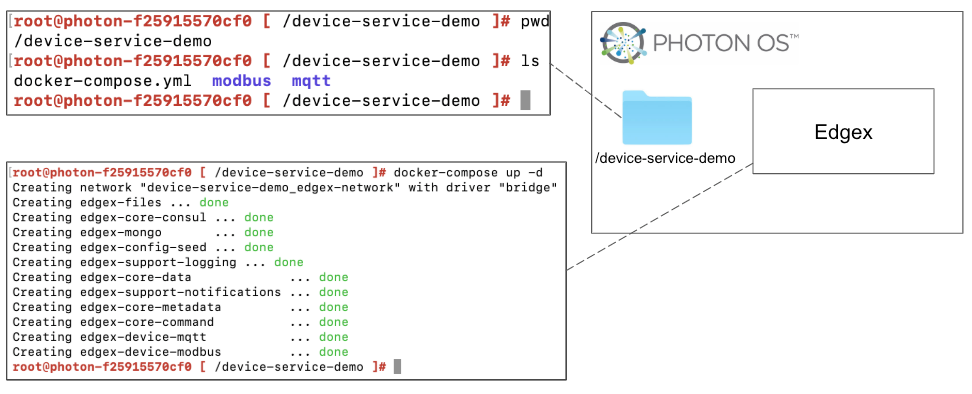
- Check the consul dashboard
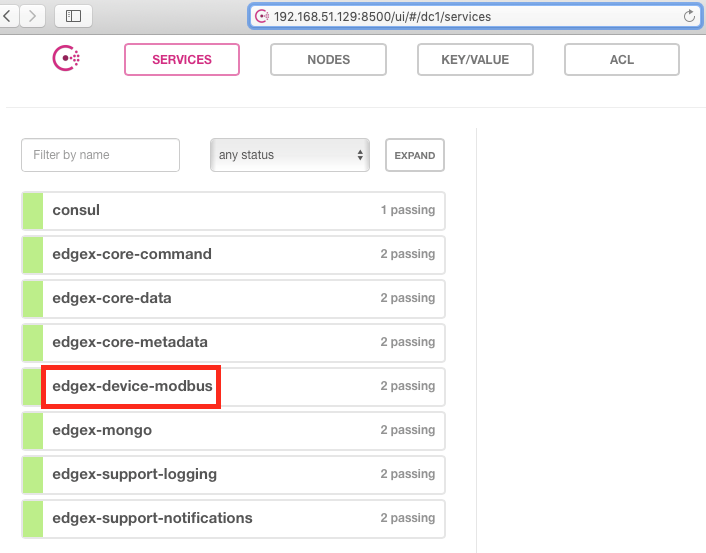
Set Up After Starting Services
If the services are already running and you want to add a device, you can use the Core Metadata API as outlined in this section. If you set up the device profile and Service as described in Set Up Before Starting Services, you can skip this section.
To add a device after starting the services, complete the following steps:
-
Upload the device profile above to metadata with a POST to http://localhost:48081/api/v1/deviceprofile/uploadfile and add the file as key "file" to the body in form-data format, and the created ID will be returned. The following example command uses curl to send the request:
$ curl http://your-edgex-server-ip:48081/api/v1/deviceprofile/uploadfile \ -F "file=@DENT.Mod.PS6037.profile.yaml" -
Ensure the Modbus device service is running, adjust the service name below to match if necessary or if using other device services.
-
Add the device with a POST to http://localhost:48081/api/v1/device, the body will look something like:
$ curl http://your-edgex-server-ip:48081/api/v1/device -H "Content-Type:application/json" -X POST \ -d '{ "name" :"Modbus-TCP-Device-2", "description":"Power Submeter device.", "adminState":"UNLOCKED", "operatingState":"ENABLED", "protocols":{ "modbus-tcp":{ "Address" : "your-device-ip", "Port" : "1502", "UnitID" : "2" } }, "labels":[ "power submeter", "modbus TCP" ], "service":{"name":"edgex-device-modbus"}, "profile":{"name":"Network Power Meter"}, "autoEvents":[ { "frequency":"50s", "onChange":false, "resource":"Configuration" }, { "frequency":"5s", "onChange":true, "resource":"Values" } ] }'The service name must match/refer to the target device service, and the profile name must match the device profile name from Step 1.
Execute Commands
Now we're ready to run some commands.
Find Executable Commands
Use the following query to find executable commands:
$ curl http://your-edgex-server-ip:48082/api/v1/device | json_pp
% Total % Received % Xferd Average Speed Time Time Time Current
Dload Upload Total Spent Left Speed
100 1718 100 1718 0 0 14081 0 --:--:-- --:--:-- --:--:-- 14081
[
{
"id" : "56dcf3ad-52d8-4d12-a2d0-ae53c177ae3d",
"commands" : [
{
"put" : {
"url" : "http://edgex-core-command:48082/api/v1/device/56dcf3ad-52d8-4d12-a2d0-ae53c177ae3d/command/67b35f63-8f94-427b-a60c-188bf9e0633a",
"parameterNames" : [
"DemandWindowSize",
"LineFrequency"
],
"path" : "/api/v1/device/{deviceId}/Configuration"
},
"id" : "67b35f63-8f94-427b-a60c-188bf9e0633a",
"get" : {
"url" : "http://edgex-core-command:48082/api/v1/device/56dcf3ad-52d8-4d12-a2d0-ae53c177ae3d/command/67b35f63-8f94-427b-a60c-188bf9e0633a",
"responses" : [
{
"description" : "service unavailable",
"code" : "503"
}
],
"path" : "/api/v1/device/{deviceId}/Configuration"
},
...
"name" : "Configuration"
}
],
...
},
{
....
}
]
Execute PUT command
Execute PUT command according to url and parameterNames, replacing [host] with the server IP when running the edgex-core-command. This can be done in either of the following ways:
$ curl http://your-edgex-server-ip:48082/api/v1/device/56dcf3ad-52d8-4d12-a2d0-ae53c177ae3d/command/67b35f63-8f94-427b-a60c-188bf9e0633a \
-H "Content-Type:application/json" -X PUT \
-d '{"DemandWindowSize":"1122","LineFrequency":"1012"}'
Aside from using device id and command id in the URL, use the following API with device name and command is another approach. Refer to Core Command API for more details.
$ curl "http://your-edgex-server-ip:48082/api/v1/device/name/Modbus-TCP-Device/command/Configuration" \
-H "Content-Type:application/json" -X PUT \
-d '{"DemandWindowSize":"1122","LineFrequency":"1012"}'
Check the result from Modbus simulator:
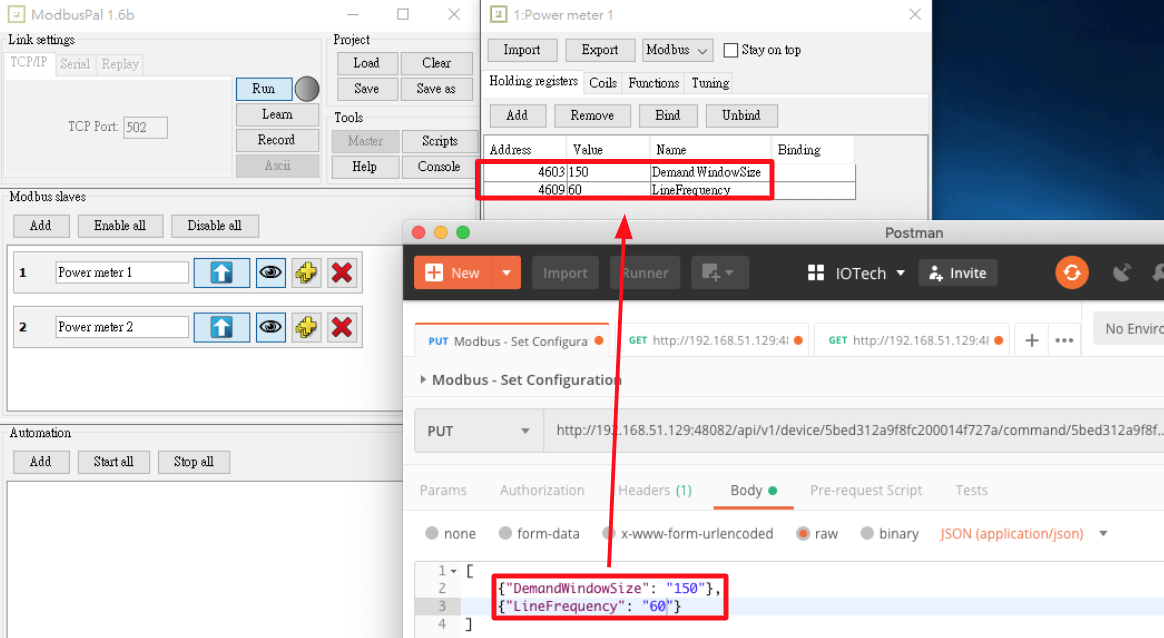
Execute GET command
Replace \<host> with the server IP when running the edgex-core-command.
$ curl "http://your-edgex-server-ip:48082/api/v1/device/name/Modbus-TCP-Device/command/Configuration" | json_pp
% Total % Received % Xferd Average Speed Time Time Time Current
Dload Upload Total Spent Left Speed
100 320 100 320 0 0 12800 0 --:--:-- --:--:-- --:--:-- 12307
{
"device" : "Modbus-TCP-Device",
"EncodedEvent" : null,
"readings" : [
{
"device" : "Modbus-TCP-Device",
"origin" : 1574314180435573491,
"name" : "DemandWindowSize",
"value" : "1122"
},
{
"origin" : 1574314180435578175,
"device" : "Modbus-TCP-Device",
"value" : "1012",
"name" : "LineFrequency"
}
],
"origin" : 1574314180435629113
}
AutoEvent
The AutoEvent is defined in the [[DeviceList.AutoEvents]] section of the TOML configuration file:
# Pre-define Devices
[[DeviceList]]
Name = 'Modbus TCP test device'
Profile = 'Test.Device.Modbus.Profile'
Description = 'This device is a product for monitoring and controlling digital inputs and outputs over a LAN.'
labels = [ 'Air conditioner','modbus TCP' ]
[DeviceList.Protocols]
[DeviceList.Protocols.modbus-tcp]
Address = '0.0.0.0'
Port = '1502'
UnitID = '1'
[[DeviceList.AutoEvents]]
Frequency = '20s'
OnChange = false
Resource = 'HVACValues'
$ curl "http://your-edgex-server-ip:48080/api/v1/event/device/Modbus-TCP-Device/10" | json_pp
% Total % Received % Xferd Average Speed Time Time Time Current
Dload Upload Total Spent Left Speed
100 1997 100 1997 0 0 216k 0 --:--:-- --:--:-- --:--:-- 216k
[
{
"origin" : 1574313452749054661,
"id" : "a066d154-fe44-4572-9870-8790017b9c59",
"created" : 1574313452750,
"device" : "Modbus-TCP-Device",
"readings" : [
...
]
},
{
"device" : "Modbus-TCP-Device",
"readings" : [
...
],
"created" : 1574313457759,
"id" : "25314175-d6f5-461e-8be4-94129fbf94c6",
"origin" : 1574313457757445677
},
...
]